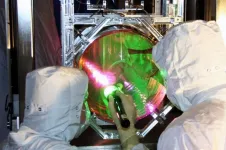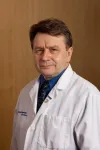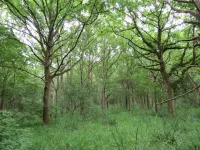Fallback strategies: Planning for climate-induced relocation
2021-06-17
(Press-News.org) Daunting and uncertain is the future for people who must decide whether, where, when, and how to vacate their homes as the climate changes. Communities who will absorb this influx of uprooted people also face challenges. In a special issue of Science, "Fallback Strategies: Planning for Climate-Induced Relocation," experts examine ways in which interdisciplinary basic and applied research can - and must - engage with and support communities and governments navigating this landscape. As this work is done, "we must consider not only what science can do, but how science is done, and by whom," emphasizes Science's senior commentary editor Brad Wible.
Considering retreat from climate change raises tensions about what losses are unacceptable and what aspects of societies should be maintained. In a Review, Katharine Mach and A.R. Siders integrate research across disciplines to chart a roadmap for retreat that is strategic and managed - i.e., designed and executed in ways that promote broader societal goals like social justice, environmental health, and cultural heritage. Such a retreat plan differs from past practice, say Mach and Siders, noting that historically, managed projects - like voluntary buyouts to move small numbers of families out of flood-prone homes in the United States - have been largely incremental adjustments implemented using a handful of policy tools and guided by a limited set of social values. These efforts have also raised equity concerns about who is offered buyouts and how they are treated in the process. The authors address the way climate retreat has been framed historically: as "a deprioritized, politically perilous option." If it were prioritized, say Mach and Siders, it could be more effective at reducing risk, more socially equitable, and more economically efficient. The authors further note the forms retreat has taken so far, but argue that managed retreat can take on even more. Implementing "lessons learned from design-thinking and planning and by integrating insights from a range of social sciences and the arts" could lead the way, Mach and Siders say. They note that pursuing such visions could lead to harms as well as beneficial outcomes; "top-down or overly techno-optimistic visions, in particular, may continue colonialist, autocratic, or otherwise unjust traditions." Key features of effective processes therefore involve factors including diverse responses; integration of local, Indigenous, scientific, and other scholarly knowledge; and meaningful public deliberation. "Our goal in authoring this article is not to suggest that managed retreat will be the optimal adaption in any place," say the authors, "but to encourage serious consideration of retreat in climate-related transformations."
The special issue also includes an Editorial that emphasizes the importance of Indigenous communities playing a leading role in any efforts involving climate-forced relocation in their homelands. "Communities forced to make the awful decision to leave their ancestral lands must define every aspect of how research occurs in order to ensure that the research supports their efforts to create long-term adaptation strategies to respond to the accelerating climate crisis," write Robin Bronen and Patricia Cochran. Five Policy Forums tackle issues ranging from the hidden costs climate change causes in terms of human displacement to a lack of bottom-up analyses in climate risk assessment, which stands to minimize the potential for human agency to find creative, locally appropriate solutions. One Policy Forum also highlights how Bangladesh, among the most vulnerable countries to climate change in South Asia, can stand as a model of disaster management, adaptation, and resilience.
INFORMATION:
ELSE PRESS RELEASES FROM THIS DATE:
2021-06-17
Using LIGO's suspended mirrors, researchers have demonstrated the ability to cool a large-scale object - the 10-kilogram optomechanical oscillator the suspended mirrors form - to nearly the motional quantum ground state. Upgrading LIGO (Laser Interferometer Gravitational-Wave Observatory) with such a modification would not only increase the device's sensitivity and range in detecting gravitational waves but could also provide new insights into large-scale quantum phenomena. For most mechanical objects to be coaxed into a quantum state, they need to be cooled to exceedingly low temperatures to overcome the thermal vibrations, or phonons, that mask the signature of quantum motion. This brings the ...
2021-06-17
Marine-terminating glaciers may be less vulnerable to rapid and irreversible collapse than previously suggested, according to a new study, which finds that ice cliff collapse is limited by upstream thinning of the ice sheet and how quickly calved icebergs and sea-ice float away. The glaciers of Greenland and Antarctica slowly flow to the sea, terminating in massive vertical ice cliffs. Occasionally, these partially submerged margins can collapse under their own weight and trigger rapid disintegration of ice sheets. It's thought that this process, called marine ice cliff instability (MICI), could lead to the catastrophic retreat of some of the planet's largest ice sheets, substantially contributing to global sea level rise. However, current ...
2021-06-17
CAMBRIDGE, MA -- To the human eye, most stationary objects appear to be just that -- still, and completely at rest. Yet if we were handed a quantum lens, allowing us to see objects at the scale of individual atoms, what was an apple sitting idly on our desk would appear as a teeming collection of vibrating particles, very much in motion.
In the last few decades, physicists have found ways to super-cool objects so that their atoms are at a near standstill, or in their "motional ground state." To date, physicists have wrestled small objects such as clouds of millions of atoms, or nanogram-scale objects, into such pure quantum states.
Now for the first time, scientists at MIT and elsewhere have cooled a large, human-scale object to close to its motional ground state. The object ...
2021-06-17
Research conducted by Qiang et al has discovered a link between a protein in red blood cells and age-related decline in cognitive performance. Published in the open access journal PLOS Biology on 17th June 2021, the study shows that depleting mouse blood of the protein ADORA2B leads to faster declines in memory, delays in auditory processing, and increased inflammation in the brain.
As life expectancies around the world increase, so are the number of people who will experience age-related cognitive decline. Because the amount of oxygen in the blood also declines with age, the team hypothesized that ...
2021-06-17
CLEVELAND--Case Western Reserve University researchers studying prions--misfolded proteins that cause lethal incurable diseases--have identified for the first time surface features of human prions responsible for their replication in the brain.
The ultimate goal of the research is to help design a strategy to stop prion disease in humans--and, ultimately, to translate new approaches to work on Alzheimer's and other neurodegenerative diseases.
Scientists have yet to discover the exact cause of Alzheimer's disease, but largely agree that protein issues play a role in its emergence and progression. Alzheimer's disease afflicts more than 6 million people in the U.S., and the Alzheimer's Association ...
2021-06-17
UTICA, NY -- More than 2 million coronary artery stents are implanted each year to help protect or restore normal blood flow to the heart, to treat patients suffering from angina or a heart attack due to coronary artery disease (CAD). While stents are highly effective and safe devices, scarring or clotting of unhealed stents can occur in a small percentage of subjects, leading to complications such as stent restenosis or thrombosis, which can be life-threatening. At present, approaches to understand stent healing based on their biological clotting status is unavailable in patients.
To devise a potential solution to this problem, Dr. Jason McCarthy, an Associate Professor at the Masonic Medical Research Institute (MMRI), and his team have developed a fluorescent probe that binds ...
2021-06-17
A long-term passive rewilding study has shown that natural woodland regeneration could make a significant contribution to meeting the UK's ambitious tree planting targets - potentially at no cost and within relatively short timescales.
The research, led by the UK Centre for Ecology & Hydrology (UKCEH), found natural growth due to seed dispersal by birds, mammals and wind can produce biodiverse and resilient woodland.
Woodland development can be rapid, while avoiding the cost, management and plastic tubing involved in planting schemes.
The study - published in the journal PLOS ONE - found that after just 15 years, previously bare agricultural ...
2021-06-17
Physicists at Ludwig-Maximilian University in Munich (LMU) and the Max Planck Institute for Quantum Optics (MPQ) have used ultrashort laser pulses to probe the dynamics of photoelectron emission in tungsten crystals.
Almost a century ago, Albert Einstein received the Nobel Prize for Physics for his explanation of the photoelectric effect. Published in 1905, Einstein's theory incorporated the idea that light is made up of particles called photons. When light impinges on matter, the electrons in the sample respond to the input of energy, and the interaction gives rise to what is known as the photoelectric effect. Light quanta (photons) are absorbed by the ...
2021-06-17
Lugano, Switzerland, 17 June 2021 - Adding an immune checkpoint inhibitor to anti-HER2 treatment in breast cancer does not improve pathological complete response (pCR), according to the primary analysis of the IMpassion050 trial presented today during the ESMO Virtual Plenary. (1) The phase III trial is the first to report data comparing a neoadjuvant anti-HER2 based regimen with or without the anti-PD-L1 antibody atezolizumab in patients with high-risk, HER2-positive early breast cancer.
The standard treatment for high-risk, HER2-positive early breast cancer is dual anti-HER2 blockade plus chemotherapy. While antibody therapy may enhance innate and adaptive immunity and activate cellular cytotoxicity, there is evidence ...
2021-06-17
(Boston)--An intrauterine fracture is a rare finding during routine prenatal imaging. This condition can be due to maternal trauma, genetic disorders of the skeleton, as well as other predisposing maternal metabolic and vascular disorders. Genetic disorders that have previously been reported to cause intrauterine fracture include brittle bone disease (osteogenesis imperfecta or OI), osteopetrosis, hypophosphatasia and Ehlers-Danlos syndrome (EDS).
Now for the first time, researchers from Boston University School of Medicine (BUSM) report a new genetic cause, unrelated to OI, for the 23 fractures that occurred in-utero to a mother with EDS hypermobility type.
EDS is a disease that weakens the bones and connective tissues ...
LAST 30 PRESS RELEASES:
[Press-News.org] Fallback strategies: Planning for climate-induced relocation


